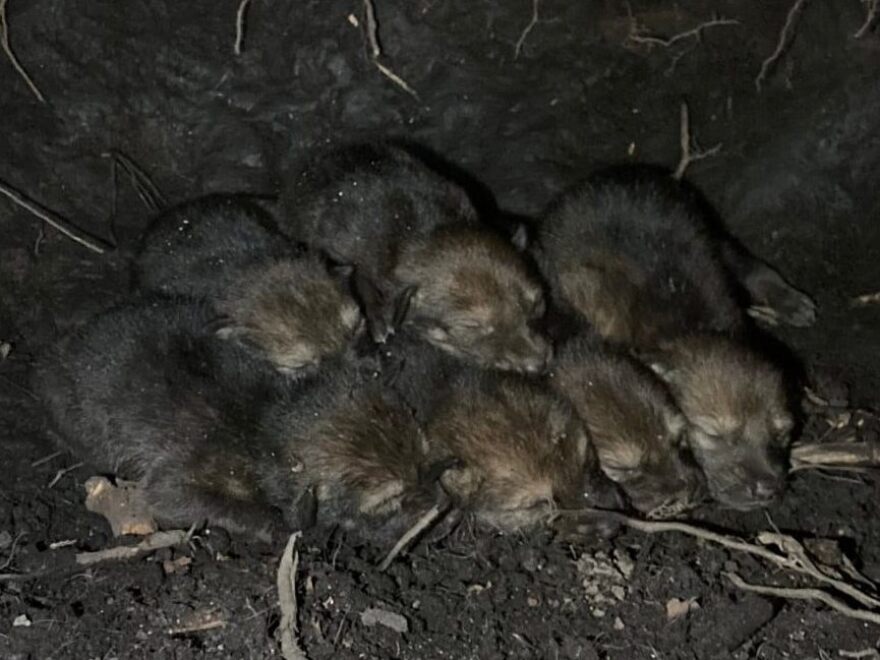U.S. Fish and Wildlife staff in North Carolina welcomed a litter of six red wolf pups into the world earlier this week. It's the first time in four years that a pair of wild red wolves — a species teetering on the brink of extinction — gave birth to a litter in the wild.
The newborn pups, four females and two males, were found in the Alligator River National Wildlife Refuge along the coast of northeastern North Carolina. Staff at the Red Wolf Recovery Program announced the paw-sitive news on Facebook Thursday.
"This new litter is the first wild-born litter of red wolves since 2018. This red wolf pair was formed through the combination of several management actions and the two red wolves subsequently following their natural instincts in pairing, establishing their territory and mating," the post read. "Every generation yields a new born hope for the red wolf...a cause for joy and celebration!"
Before settlers arrived in North America, red wolves thrived throughout the Southeast U.S, from Florida to the Great Plains and the Ohio River Valley, according to national conservation organization Defenders of Wildlife. But through hunting, extermination and the expansion of cities and towns, humans drove the species to near extinction.
There were a mere 17 wolves left to save when the Endangered Species Act passed in 1973. Before 14 of the remaining 17 wolves were trapped and transferred into captivity, the handful of survivors lived across a small area of the Louisiana and Texas coast.
The remaining wolves disappeared, Fish and Wildlife said, attributed to continued human persecution and a loss of habitat. The red wolf was declared extinct in the wild in 1980.
Just four years later, there were 63 healthy red wolves in captivity, which were being prepared to release into the wild with hopes of giving the species a second chance. As part of the Red Wolf Species Survival Plan, the Red Wolf Recovery Program said, more than 60 adult wolves were released into the Alligator River National Wildlife Refuge between 1987 and 1994.
In the following years, the wolves did what came naturally: They maintained territories, formed packs and more importantly, began to breed.

As other environmentalists marveled at the success of the Red Wolf Recovery Program, it became a model for reintroduction efforts of gray wolves, Mexican wolves, California condors and the black-footed ferret.
In 2012, the population reached a peak of 120. According to the FWS, this was the first time a large carnivore was brought back from extinction and reintroduced to the wild in the U.S.
But once again, humans threatened the handful of the surviving wolves.
Conservationists came to the wolves' aid once again in 2012, after one red wolf after another was shot and killed, having been mistaken for a coyote, according to a Southern Environmental Law Center news release. The North Carolina Wildlife Resources Commission had recently approved a temporary rule allowing hunters to kill coyotes, which occasionally breed with the wolves, at night in the area where red wolf was trying to make a comeback.
The population had dropped to 100 by the time a settlement was reached between environmentalists and the NCWRC. Spotlight hunting at night was outlawed and hunters were required to carry a permit for coyote hunting during daylight hours.

But the number of wolves continued to dwindle, reaching a concerning low population estimate of 17-20 in 2020 and 2021. There has been a steady decline in red wolves born in the wild from 2008, which saw 47 new wolves, to only four pups in 2018. Fish and Wildlife didn't report a single red wolf birth in the wild in 2019, 2020 or 2021.
Which is why the recent litter of six is such exciting news to conservationists and wolf enthusiasts alike. As of today, there are an estimated 15 to 17 red wolves living in the wild. Another 241 exist in captivity. They continue to be one of the most endangered animals on the planet.
Copyright 2022 NPR. To see more, visit https://www.npr.org.


